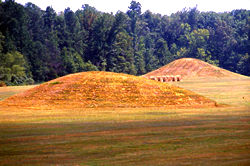Pharr Mounds | |
 Two mounds at the Pharr Mounds site | |
| Nearest city | Tupelo, Mississippi |
|---|---|
| Coordinates | 34°27′59.3562″N88°25′0.1734″W / 34.466487833°N 88.416714833°W |
| NRHP reference No. | 78000346 [1] |
| Added to NRHP | February 23, 1978 [1] |
Pharr Mounds is a Middle Woodland period archaeological site located near Tupelo in parts of Itawamba and Prentiss counties in northern Mississippi. This complex was made of earthwork mounds.
Contents
The complex of eight dome-shaped, tumulus burial mounds was in use during the Miller 1 phase of the Miller culture. [2] These were constructed as earthwork mounds between 1 and 200 CE. The complex is considered to be one of the largest and most important sites from this era. [3] It was listed on the National Register of Historic Places in 1978 as part of the Natchez Trace Parkway at milepost 286.7. [1]



